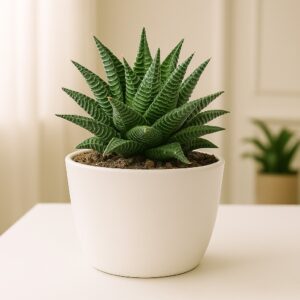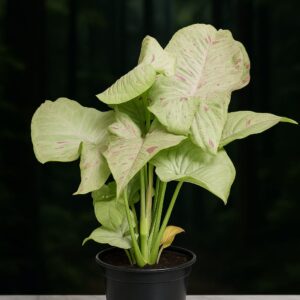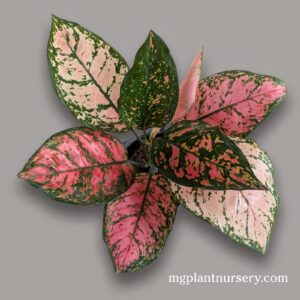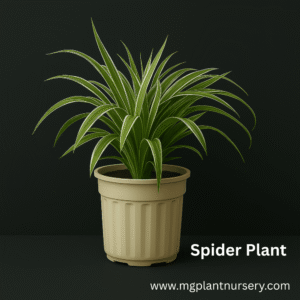The Hoya Hindu Rope, scientifically known as Hoya carnosa ‘Compacta’, is a captivating houseplant celebrated for its distinctive, twisted foliage and fragrant, star-shaped blooms. This slow-growing, semi-succulent vine is a favorite among plant enthusiasts for its unique appearance and relatively low maintenance requirements.
🌿 Botanical Overview
-
Scientific Name: Hoya carnosa ‘Compacta’
-
Common Names: Hindu Rope, Krinkle Kurl
-
Family: Apocynaceae (Dogbane family)
-
Origin: Native to Eastern Asia and Australia
-
Growth Habit: Trailing or climbing vine, ideal for hanging baskets or trellises
-
Size: Typically grows 12–18 inches (30–45 cm) tall and 8–12 inches (20–30 cm) wide indoors
🍃 Foliage and Color Variations
The Hoya Hindu Rope’s most striking feature is its thick, waxy leaves that curl and twist along the vine, creating a rope-like appearance. These leaves are typically a deep green, but several variegated cultivars offer additional visual interest:
-
H. compacta ‘Regalis’: Features white variegation along the leaf edges, reminiscent of Hoya carnosa ‘Krimson Queen’.
-
H. compacta ‘Mauna Loa’: Displays creamy-white variegation in the leaf centers, similar to Hoya carnosa ‘Krimson Princess’.
-
H. compacta ‘Jodie’s Silver’: Known for its lighter leaves with a silvery “splash” pattern.
These variegated varieties add a touch of elegance and diversity to any indoor plant collection.
🌸 Flowers: Appearance and Fragrance
When mature and provided with optimal care, the Hoya Hindu Rope produces clusters of small, star-shaped flowers. These blooms are typically pinkish-white with red centers and have a waxy texture. They emit a sweet, subtle fragrance, often compared to chocolate. Each flower cluster, or umbel, can contain numerous individual flowers and may last for several weeks. Blooming usually occurs in the warmer months, but with proper conditions, the plant can flower multiple times a year.
🌞 Light Requirements
Hoya Hindu Rope plants thrive in bright, indirect light. While they can tolerate some direct morning or evening sun, exposure to harsh midday sunlight can scorch the leaves. Insufficient light may lead to leggy growth and reduced flowering. An east-facing window is often ideal, providing ample light without the intensity of direct sun.
🌡️ Temperature and Humidity
-
Temperature: Prefers temperatures between 60°F and 80°F (15°C to 27°C). Avoid exposing the plant to temperatures below 50°F (10°C), as prolonged cold can cause damage.
-
Humidity: While the Hoya Hindu Rope can tolerate average indoor humidity levels, it thrives in higher humidity environments. To increase humidity, consider placing a humidifier nearby, grouping plants together, or placing the pot on a tray filled with water and pebbles.
💧 Watering and Soil
-
Watering: Allow the top inch of soil to dry out between waterings. Water thoroughly until excess water drains from the bottom of the pot. Reduce watering frequency during the winter months when the plant’s growth slows.
-
Soil: Use a well-draining, slightly acidic soil mix rich in organic matter. A combination of peat moss, perlite, and succulent potting soil in a 2:1:1 ratio is ideal. Adding orchid bark can further improve aeration and drainage.
🌱 Fertilization
During the growing season (spring and summer), feed the Hoya Hindu Rope plant every two to four weeks with a balanced, water-soluble fertilizer diluted to half strength. Avoid fertilizing in the winter months when the plant is dormant.
✂️ Pruning and Maintenance of Hoya Hindu Rope
Pruning is generally minimal due to the plant’s slow growth. However, you can trim back leggy stems or remove dead or damaged leaves to maintain its appearance. Importantly, avoid removing the peduncles (the leafless spurs from which flowers emerge), as the plant reuses these structures for blooming.
🌼 Encouraging Blooms for Hoya Hindu Rope
To promote flowering:
-
Ensure the plant receives ample bright, indirect light.
-
Maintain consistent temperatures and humidity levels.
-
Allow the plant to become slightly root-bound, which can encourage blooming.
-
Use a phosphorus-rich fertilizer during the growing season.
-
Provide a slight drop in nighttime temperatures during winter to mimic natural conditions.
Patience is key, as it may take several years for a Hindu Rope plant to mature and begin flowering.
🌿 Propagation
Hindu Rope plants can be propagated through stem cuttings:
-
Select a healthy vine with at least two to three nodes.
-
Cut just below a node using clean scissors.
-
Remove the leaves from the lower nodes, leaving a few at the top.
-
Allow the cutting to dry overnight.
-
Place the cutting in water or moist, well-draining soil.
-
Keep the cutting in a warm, humid environment with bright, indirect light.
Roots should develop in a few weeks, after which the new plant can be potted in soil.
🐛 Common Pests and Diseases
-
Pests: Mealybugs and spider mites are common pests that can infest Hindu Rope plants. Regularly inspect the plant, especially the curled leaves where pests can hide. Treat infestations with neem oil or insecticidal soap.
-
Diseases: Overwatering can lead to root rot and fungal diseases. Ensure proper drainage and avoid letting the plant sit in water.
🐾 Pet Safety
Hindu Rope plants are non-toxic to pets, making them a safe choice for households with cats and dogs.
🌟 Final Thoughts
The Hoya Hindu Rope is a unique and visually appealing houseplant that rewards patience and proper care with stunning blooms and lush, twisted foliage. Its low maintenance requirements and non-toxic nature make it an excellent addition to any indoor plant collection. With the right conditions, this plant can thrive and bring beauty to your home for many years.
Follow us on facebook. click here.
Buy more indoor plants here.






Reviews
There are no reviews yet.